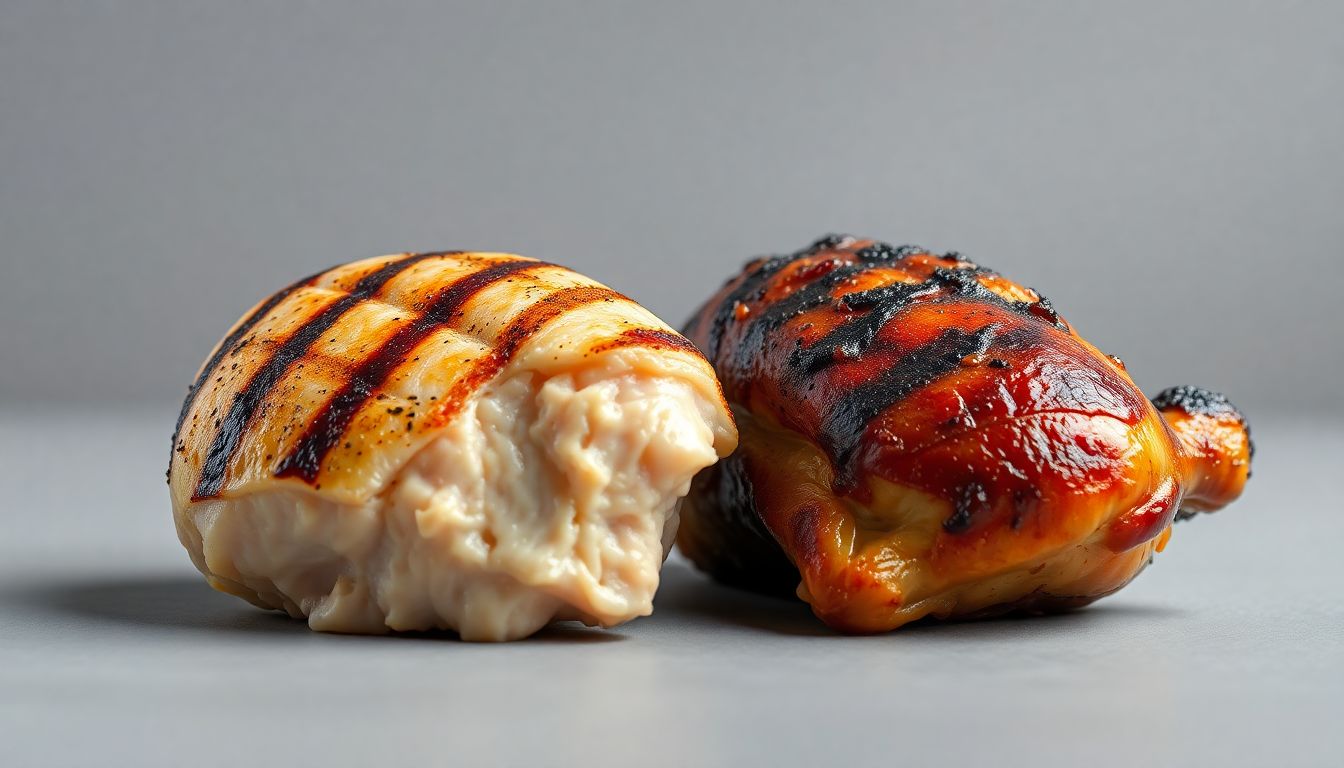
White Meat vs. Dark Meat: Unlocking the Nutritional Differences and Culinary Uses
Chicken, turkey, duck – we love them all! But have you ever wondered what the real difference is between white meat and dark meat? Is one type actually healthier? Don't worry, we'll break it down so you can make the best choices for your plate and health. Get ready to learn the secrets behind poultry!
What Exactly Defines White Meat and Dark Meat?
The color difference in meat comes from the type of muscle fibers. Think of it like different engines in a car! Poultry and some fish have both kinds of meat.
- Fast-Twitch Muscle Fibers: These fibers are what make white meat, like chicken breast. These fibers help with quick bursts of energy. White meat uses less oxygen and stores energy as glycogen.
- Slow-Twitch Muscle Fibers: Dark meat, such as chicken thighs, uses these fibers. Myoglobin is in these fibers. Myoglobin holds oxygen and makes the meat dark. Slow-twitch fibers help muscles work for a long time.
- Visual Examples: Chicken breast and turkey breast are white meat. Chicken thighs and drumsticks are dark meat. These parts move differently.
Nutritional Breakdown: White Meat vs. Dark Meat
Let's check out the facts! Both white and dark meat bring important nutrients. Neither one is a clear winner, it all boils down to what your body requires.
- Protein Content: Both white and dark meat are full of protein. Protein helps build and repair muscles. Each offers about the same amount of lean protein per serving.
- Fat Content: Dark meat usually has more fat, including saturated fat. Fat adds flavor and keeps the meat juicy. White meat has less fat, if that is what you are looking for.
- Vitamin and Mineral Differences: Dark meat wins in the vitamin and mineral department! You'll find more iron and zinc. It also has more B vitamins, which give you energy. White meat still has these nutrients, but it's less of them.
- Calorie Comparison: White meat typically has fewer calories per serving than dark meat. This difference can be small though, especially if you remove the skin! How you cook it also impacts the calories.
Flavor Profiles and Culinary Applications
Time to talk about taste! White meat and dark meat taste and feel different when you eat them. Their different tastes makes them better suited for particular dishes.
- White Meat: White meat has a mild taste and can be drier. It's great grilled, poached, or baked. Chicken breast with lemon and herbs is a classic choice.
- Dark Meat: Dark meat is richer and juicier. Braising and roasting bring out the best flavors. Think chicken thighs in a hearty stew.
- Recipe Examples: For white meat, try a simple grilled chicken salad. For dark meat, make a delicious chicken pot pie. Each meat brings something unique to the table.
Debunking Common Myths About White and Dark Meat
Let's clear up some confusion. There are myths out there about white and dark meat that just ain't right.
- Myth: White meat is always healthier. While it's lower in fat, it lacks some nutrients found in dark meat. A healthy diet requires balance. Dark meat is good for you, too!
- Myth: Dark meat is only for people who like "strong" flavors. Dark meat is super versatile! It can be used in lots of recipes. The richer flavor works well with spices and sauces.
- Myth: White meat is always dry. Cook it right, and white meat is juicy. Marinating and using the right cooking time help. Overcooking dries it out!
Choosing the Right Meat for Your Needs
So, which one should you pick? Consider your goals!
- For Weight Management: Lean white meat is a good option. Remove the skin and bake or grill it. This keeps the calories low.
- For Maximum Nutrient Intake: Choose dark meat for iron and zinc. It's good for your overall health. If you are low in iron, this is a great choice.
- For Flavor and Texture Preferences: Do you like mild or rich flavors? Do you like drier or juicy meat? Pick what you enjoy!
- Consider the Cooking Method: Grilling keeps white meat lean. Braising makes dark meat tender. The cooking method affects the flavor and nutrients.
Conclusion: Embracing the Diversity of Poultry
White meat and dark meat each have their own awesome qualities. The "best" choice depends on what you need. It also comes down to what you like! Enjoy the variety and get the most out of poultry.



0 Comments